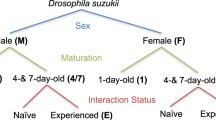Abstract
Drosophila santomea and Drosophila yakuba are two sister species inhabiting Saõ Tomé island. Previous studies showed that both species display strong reproductive isolation, although they can produce a few viable hybrids. Our study tried to understand the mechanism of this ethological isolation between two allopatric strains. A strong sexual isolation was confirmed, with a marked asymmetry. Comparisons of latency times to either courtship or copulation suggest that males do not discriminate females, whereas D. yakuba females, but not D. santomea females, accept their homospecifics more quickly. Cuticular hydrocarbon compositions of both species and sexes were also established with gas chromatography (GC) and GC/mass spectrometry analysis. All have (Z)-7-tricosene as their major compound. There are several quantitative differences between species for few minor compounds. The largest difference concerns n-heneicosane, which is more abundant in D. santomea than in D. yakuba flies (up to seven times more between males). A similar quantitative difference was also found in a pair of sympatric strains. Furthermore, D. yakuba males artificially perfumed with n-heneicosane were discriminated negatively by D. yakuba females, suggesting a role for this compound in the sexual isolation between these two species.

Similar content being viewed by others
References
M. Cobb J. M. Jallon (1990) ArticleTitlePheromones, mate recognition and courtship stimulation in the Drosophila melanogaster species sub-group Anim. Behav. 39 1058–1067
J. A. Coyne S. Y. Kim A. S. Chang D. Lachaise S. Elwyn (2002) ArticleTitleSexual isolation between two sibling species with overlapping ranges: Drosophila santomea and Drosophila yakuba Evolution 56 2424–2434 Occurrence Handle12583583
A. Ewing (1983) ArticleTitleFunctional aspects of Drosophila courtship Biol. Rev. 58 275–292
J.-F. Ferveur (2005) ArticleTitleCuticular hydrocarbons: Their evolution and roles in Drosophila pheromonal communication Behav. Genet. 35 279–295 Occurrence Handle10.1007/s10519-005-3220-5 Occurrence Handle15864443
J. M. Jallon (1984) ArticleTitleA few chemical words exchanged between Drosophila during courtship and mating Behav. Genet. 14 441–478 Occurrence Handle10.1007/BF01065444 Occurrence Handle6441563
J. M. Jallon J. R. David (1987) ArticleTitleVariations in cuticular hydrocarbons among the eight species of the Drosophila melanogaster subgroup Evolution 41 294–302
D. Lachaise M. Harry M. Solignac F. Lemeunier V. Benassi M. L. Cariou (2000) ArticleTitleEvolutionary novelties in islands: Drosophila santomea, a new melanogaster sister species from Saõ Tomé Proc. R. Soc. Lond., B Biol. Sci. 267 1487–1495
A. Llopart S. Elwyn D. Lachaise J. A. Coyne (2002) ArticleTitleGenetics of a difference in pigmentation between Drosophila yakuba and Drosophila santomea Evolution 56 2262–2277 Occurrence Handle12487356
J. R. Rouault C. Marican C. Wicker-Thomas J. M. Jallon (2004) ArticleTitleRelations between hydrocarbon polymorphism, resistance against desiccation and breeding temperature; a model for HC evolution in D. melanogaster and D. simulans Genetica 120 195–212 Occurrence Handle10.1023/B:GENE.0000017641.75820.49 Occurrence Handle15088658
D. Scott (1994) ArticleTitleGenetic variation for female mate discrimination in Drosophila melanogaster Evolution 48 112–121
Acknowledgments
We thank Dr Daniel Lachaise for providing all strains collected on Saõ Tomé island. Also, thanks to Helena Alvès for her technical help in CHC analyses and to Dr David Carlson for gifts of synthetic tricosenes and pentacosenes.
Author information
Authors and Affiliations
Corresponding author
Rights and permissions
About this article
Cite this article
Mas, F., Jallon, JM. Sexual Isolation and Cuticular Hydrocarbon Differences between Drosophila santomea and Drosophila yakuba. J Chem Ecol 31, 2747–2752 (2005). https://doi.org/10.1007/s10886-005-7570-5
Received:
Revised:
Accepted:
Published:
Issue Date:
DOI: https://doi.org/10.1007/s10886-005-7570-5




